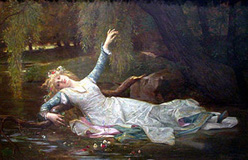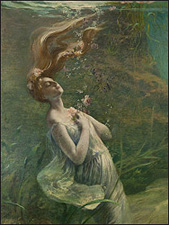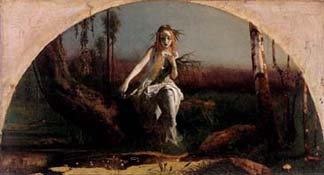The Ophelia Page
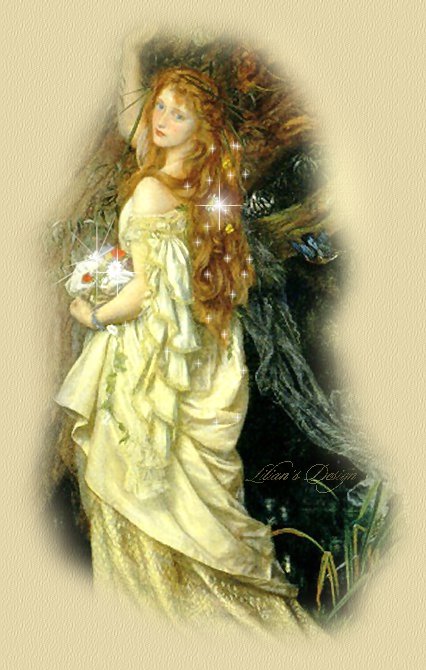
There's rosemary, that's for remembrance; pray,
love, remember: and there is pansies. that's for thoughts.
There's fennel for you, and columbines: there's rue
for you; and here's some for me: we may call it
herb-grace o' Sundays: O you must wear your rue with
a difference. There's a daisy: I would give you
some violets, but they withered all when my father
died: they say he made a good end,--
From Act IV, Scene V of William Shakespeare's Hamlet, and
printed on the frame of Arthur Hughes' painting Ophelia (1863).

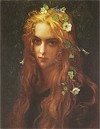
Ophelia by Ernest Hebert
'Who is Ophelia?'
Literary Theory & Feminist Criticism
"Whereas for Hamlet madness is metaphysical, linked with culture, for Ophelia it is a product of the female body and female nature. . . . Ophelia's virginal and vacant white is contrasted with Hamlet's scholar's garb, his 'suits of solemn black.' Her flowers suggest the discordant double images of female sexuality as both innocent blossoming and whorish contamination; she is the 'green girl' of pastoral, the virginal 'Rose of May' and the sexually explicit madwoman who, in giving away her wild flowers and herbs, is symbolically deflowering herself. . . . The mad Ophelia's bawdy songs and verbal license, while they give her access to 'an entirely different range of experience' from what she is allowed as the dutiful daughter, seem to be her one sanctioned form of self-assertion as a woman, quickly followed, as if in retribution, by her death." (Elaine Showalter, "Representing Ophelia")
Representing Ophelia: Women, Madness, and the Responsibilities of Feminist Criticism--excellent Elaine Showalter article from which the quotations on this web page were taken. Includes a survey of historical and current interpretations of the character of Ophelia.
Reading Ophelia's Madness--"Motherless and completely circumscribed by the men around her, Ophelia has been shaped to conform to external demands, to reflect others' desires. . . . Ophelia is fragmented by contradictory messages."
Assembling the Ophelia Fragments: Gender, Genre, and Revenge in Hamlet --" Examining the Ophelia fragments, those few moments that Ophelia appears on stage in person or in the dialogue of other characters, clarifies how thoroughly she undergoes, in feminine form, not only Hamlet's struggle between the twin impulses toward murder and self-destruction but also the ambiguous resolution of the conflict between what he calls in "To be or not to be" "conscience" or "resolution" and "opposing" or "suffering." Ophelia, in other words, takes an ambiguously achieved revenge, as does Hamlet, but from within the form that is most appropriate to her gender, the courtly love tragedy."
By the Way, Ophelia is Pregnant--interesting approach.
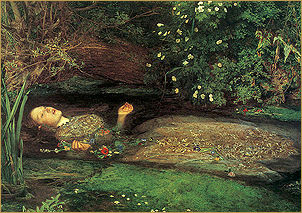
The most famous 'Ophelia' painting:
Ophelia by John Everett Millais.
(Click on painting to enlarge it.)
Millais's Ophelia--contemporary responses to the painting.
Millais's Ophelia--everything you ever wanted to know about the artist and his famous painting.
Ophelia (Millais painting) --good discussion.
Millais's Ophelia: Symbolism --identifies the flowers and birds in Millais's painting.
Ophelia Paintings
". . . [S]uperintendents of Victorian lunatic asylums were also enthusiasts of Shakespeare. . . . The case study of Ophelia was one that seemed particularly useful as an account of hysteria or mental breakdown in adolescence, a period of sexual instability which the Victorians regarded as risky for women's mental health. . . . Reality, psychiatry, and representational convention were even more confused in the photographic records of hysteria produced in the 1870s by Jean-Martin Charcot. . . ; his women patients were coached in their performances for the camera, and, under hypnosis, were sometimes instructed to play heroines from Shakespeare. . . . [T]he Victorian madwoman looks mutely out from men's pictures, and acts a part men had staged and directed . . . ." (Elaine Showalter, "Representing Ophelia")
Ophelia -- Victimized Woman or Femme Fatale?--commentary on the Ophelias of Millais and Rossetti.
Ophelia --two pages of Ophelia images (some not seen above) interspersed with quotations and selected Ophelia scenes from the play. Click link to "Mad Ramblings of Ophelia" at bottom of page.
Ophelia (Emory U)--many links to Ophelia paintings, arranged chronologically. See also Rusche's Shakespeare Illustrated.
Frailty, thy name is woman: An Ophelia Gallery--good selection of 19th Century painting of Ophelia.
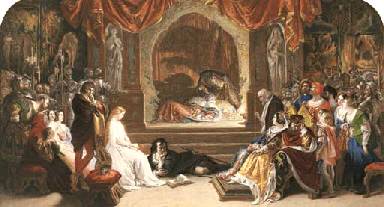
The Play Scene in Hamlet" by Daniel Maclise ( 1842)
Ophelia, Hamlet, and the court watching the "mousetrap" play-within-a-play.
Ophelia on Stage and in Films, Fictions, Art, Music, Dance, and Pop Culture
"But since the 1970s too we have had a feminist discourse which has offered a new perspective on Ophelia's madness as protest and rebellion. For many feminist theorists, the madwoman is a heroine, a powerful figure who rebels against the family and the social order; and the hysteric who refuses to speak the language of the patriarchal order, who speaks otherwise, is a sister." (Elaine Showalter, "Representing Ophelia")
REFERENCE
References to Ophelia--in art, literature, music, computer games, science, and pop culture.
THEATRICAL & ARTISTIC PRODUCTIONS
Ophelia's Mad Scene Part 1--YouTube excerpt from the 2009 BBC production of Hamlet, starring Mariah Gale as Ophelia.
The Structure of Shakespearian Revolutions: Witnessing a Paradigm Shift in PreRaphaelite and Theatrical Portrayals of Hamlet’s Ophelia--"During the Victorian period and the decades preceding it,. . . the “true” Ophelia that emerged was most often a delicate, pure, and innocent one, who meshed with the era’s vision of the ideal, virtuous female. . . . The work of a key group of Pre-Raphaelite painters and innovative stage actors produced representations of Ophelia that emphasised her darker, unsavoury qualities, which in turn engendered a large-scale re-imagination and re-complication of Shakespeare’s tragic heroine."
"There is no 'true' Ophelia” : Changing Representations of Ophelia 1661-1914-- This essay studies "the representation of Ophelia between the years of 1661 and 1914--from the first professional actress to play Ophelia on the English stage to the burgeoning of the suffrage movement and the rise of the New Woman. . . . By charting the representation of Ophelia from 1661 to 1914 we can chart changing conceptions of femininity and women's mental health and the beginnings of a movement to reclaim femininity from patriarchal ownership."
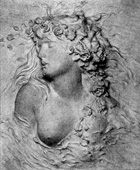
'Ophelia' (1880)
by Sarah Bernhardt.
Sarah Bernhardt's Ophelia--"This essay argues that both Sarah Bernhardt's 1880 sculpture of the drowned Ophelia and her later, on-stage appearance in 1886 as the dead Ophelia contributed significantly to the nineteenth-century obsession with death and sexuality. . . . Bernhardt added subversive aspects that hinted at the nature of the female subject and the afterlife of Ophelia that would continue to play a significant role in visual culture in the twentieth and twenty-first centuries."
Handling Ophelia: A Story in Four Unscripted Scenes--"This article examines the stage struggle to 'recuperate' an Ophelia that both discursive criticism and visual objectification bury prematurely – albeit by different means and for different aims – when claiming, in Laertes’s words: ‘The woman will be out’ (IV.7.189). Taking Laertes’s words to mean both taking the woman out and putting the woman on view, I will offer a preliminary survey of the customary textual cuts and their effect on Ophelia’s part, explore ‘the four unscripted scenes’ three European directors: Vlad Mugur, Radu Alexandru Nica, and Jan Klata, have built into their respective productions of the play, and interrogate their overall impact on interpreting Ophelia’s part, agency and story within Shakespeare’s Hamlet."
Rereading Shakespeare's Ophelia: Marcelo Marchioro's Performance Aesthetics--"To convey the disintegration of the character’s psychic identity, her gradual drifting into madness, the director decided to cast two actresses for the role of Ophelia: on the one hand, the heroine’s external, socially constructed mask and, on the other, her Doppelgänger, an expressionistic device to reveal the character’s inner state of mind."
FILM
Cultural Anxiety and the Female Body --excellent analysis of Zefferelli's film Hamlet. "By analyzing the director's handling of the Nunnery and Mousetrap scenes in terms of the female body, I argue that compared to Shakespeare's original text, Zeffirelli's representations, although seemingly liberal, actually strip women of power. . . . Zeffirelli endows Hamlet with absolute power in the film to signal the increasing anxiety of contemporary culture over the progress of the women's movement and the increasing power of women in cultural production."
Empowered by Madness: Ophelia in the Films of Kozintsev, Zeffirelli, and Branagh --"Thee different interpretations of Ophelia in three different films shot between the years 1964 and 1996 will be discussed both in relation to one another and in relation to the feminist discourse of representation that opens up new ways of reading Ophelia."
Silencing Ophelia: Male Aurality as a Controlling Element in Olivier's Hamlet--"I will demonstrate how composer William Walton's musical approach to Ophelia in Laurence Olivier's 1948 film of Hamlet establishes a 'male aurality' that accompanies director Olivier's male gaze, the combination of which causes Ophelia to become even more marginalized."
Sexuality and Silence: The Representation of Ophelia in a Tibetan Adaptation of Shakespeare’s Hamlet--In the Asian film Prince of the Himalayas, "the character of Odsaluyang [Ophelia] is not delicately portrayed as a speaking subject, but her sexual relationship with Lhamoklodan [Hamlet] partly indicates her silent protest against a patriarchal system. Furthermore, the depiction of her giving birth to a baby in the river is striking. . . , underlining her significant role in changing the tone of the tragedy. In the film, Odsaluyang’s silence remains the center of attention. Especially when she confronts her ultimate silence in death, she is in perfect harmony with the vastness and tranquility of nature."
The "New" Ophelia in Michael Almereyda's "Hamlet," --"The majority of modern filmic renditions of Ophelia expose the enduring influence of the ideological alignment among femininity, docility, weakness, and hysteria that underpins far earlier representations of this character. I argue, however, that a far more progressive and innovative interpretation of the play in terms of Ophelia representation can be found in the most recent film adaptation, Hamlet (2000), directed by Michael Almereyda. Here, Hollywood finally affords Ophelia a level of ideological potency that would appear to rival Hamlet himself."
"Maddening Endurance": Post-modern Images of Ophelia’s Madness --"From the analysis of the text, supported by categories from depth psychology, I demonstrate that [Heiner Müller’s] Hamletmaschine promotes Ophelia’s madness as a revolutionary gesture against the logic of oppression: a means to trigger chaos on stage in order to generate a new cosmos in the audience’s world of conventions."
FICTION
Ophelia Transformed: Revisioning Shakespeare's Hamlet --"This article intends to investigate certain aspects of Ophelia's character in three revisioning works of Hamlet: Lisa Klein's Ophelia (2006), Graham Holderness's The Prince of Denmark (2002), and Matt Haig's The Dead Fathers Club (2006). . . . The three revisionings of Hamlet in this article adopt differing trajectories, yet certain dimensions of Ophelia's character appear to be the common denominators or the points of departure among them."
Reviving Ophelia: Reaching Adolescent Girls through Shakespeare's Doomed Heroine-- "In Dating Hamlet (2002) and Ophelia (2006), Fiedler and Klein re-create Ophelia by presenting her as a capable, headstrong teenage girl who can survive the painful circumstances that drive her Shakespearean predecessor to madness and early death. By revising Ophelia and creating newer, more assertive versions in their novels, Fiedler and Klein subvert the critical tradition of Hamlet and invert the popular perception of Ophelia in an effort to create relatable role-models for their young readers."

'Ophelia' (1880) by
Anna Lea Merritt.
The Girlhood of Shakespeare's Heroines--the fictionalized childhood of Shakespeare's heroines by 19th-century Mary Cowden Clarke; the third tale, "Ophelia: The Rose of Elsinore," gives a pre-Freudian account of the trauma that formed Ophelia's sexual identity .
‘Ophelia’ is Not ‘Hamlet’, and That’s to the Character’s Detriment --book review of Lisa Klein's novel Ophelia which develops an excellent interpretation of Shakespeare's character Ophelia.
Shakespeare's Heroines: Characteristics of Women, Moral, Poetical and Historical --influential 19th-century interpretation by Mrs. Jameson.
MUSIC AND DANCE
Interdisciplinary Shakespeare: A Multi-media Approach--impact of Shakespeare and the character of Ophelia on the music and life of Hector Berloiz ("The Death of Ophelia," "The Funeral Scene of Hamlet," "Symphony Fantastique," etc.); early productions of Hamlet; impact of early costuming and dance; Hamlet viewed through the eyes of earlier French critics and audiences; etc. See, in particular, the section on Psychology ("Ophelia as Hysteric") --a 19th century romantic interpretation of the character.
Dancing with Shakespeare: Tom Stroud and Winnepeg's Contemporary Dancers --review/description of an experimental dance production of Hamlet.
POP CULTURE
The Death of Shakespeare's Ophelia, Popular Culture, and Web 2.0--"To examine the contents of Web 2.0 is to open a remarkably revealing window into popular culture. Those who open this window quickly discover that, contrary to the predictions of certain commentators, Shakespeare awareness is not in decline in our age but within popular culture possesses a vigorous and burgeoning afterlife. . . . [T]he interactive tools that are so central a feature of Web 2.0 encourage the exponential growth of that process of reinvention."
'A Document in Madness': Do Indian Women Mirror Ophelia?--Kalki Koechlin, an Indian actress and screenwriter of French ethnicity, draws parallels between Ophelia's and Indian women's lives, based on sensitive readings of both.
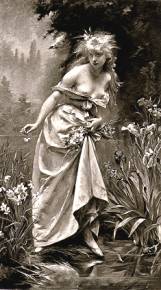
Ophelia by Madeline Lemaire

Hamlet Links
- Hamlet Online --many, many helpful links.
- Hamlet and Co.--many helpful links.
- The Oedipus-Complex as An Explanation of Hamlet's Mystery: A Study in Motive --complete text of Ernest Jones' famous Freudian reading.
- Too Much in the (Black) Sun: Hamlet's First Soliloquy, A Kristevan View --Crunelle-Vanrigh's scholarly article based on a new psychoanalytic reading.
- Making Mother Matter: Repression, Revision, and the Stakes of 'Reading Psychoanalysis Into' Kenneth Branagh's Hamlet --scholarly article.
Shakespeare Links
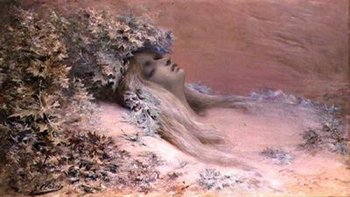
Ophelia in the Thistles by Georges Clairin
Return to Gender, Literature, and Art Index
All Elaine Showalter quotations in the headnotes are from "Representing Ophelia: Women, Madness, and the Responsibilities of Feminist Criticism" in Shakespeare and the Question of Theory, eds. Patricia Parker and Geoffrey Hartman (Methuen 1985) 77-94.
Comments/suggestions: knichols11@cox.net
Updated: 1-14-17
